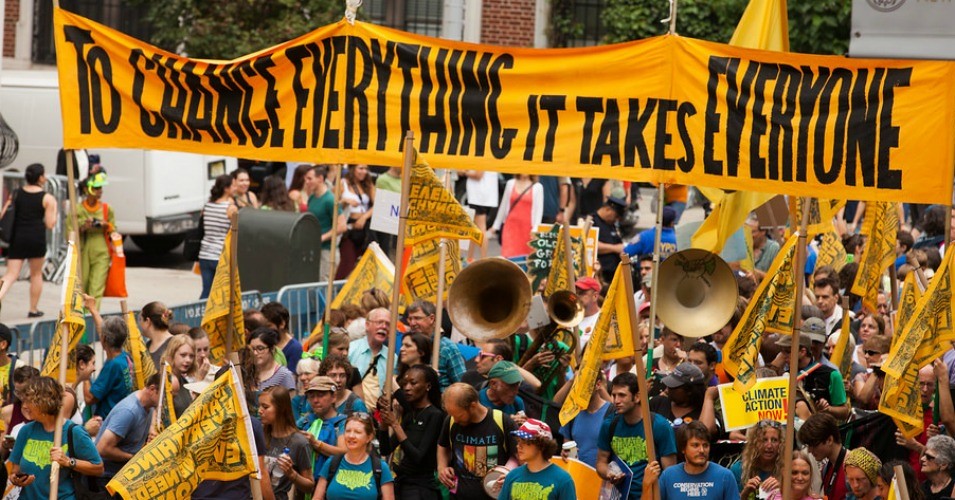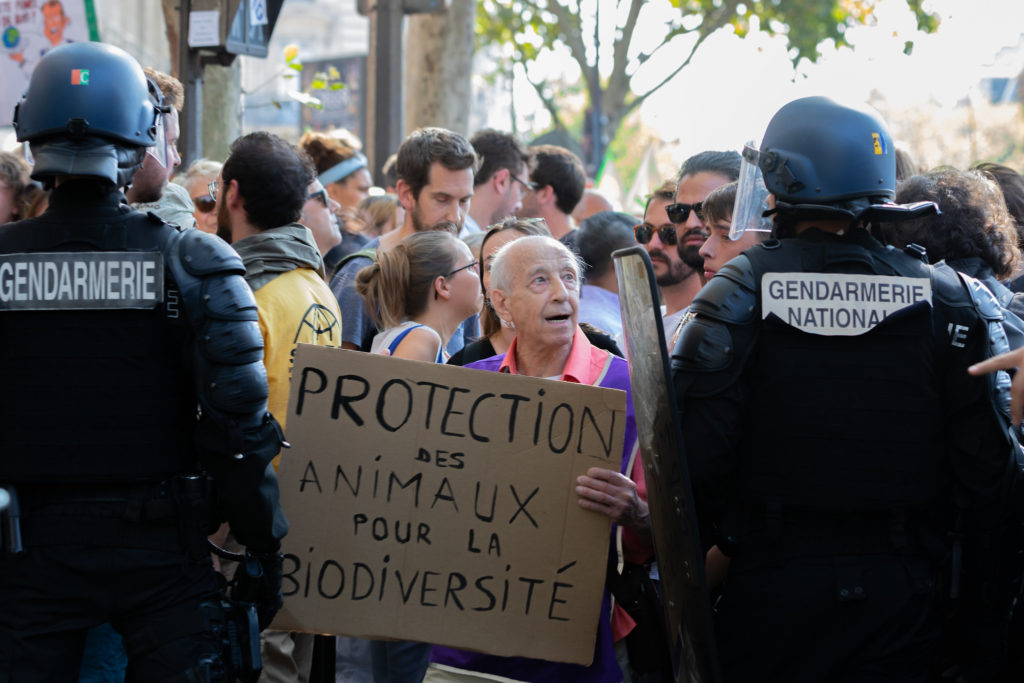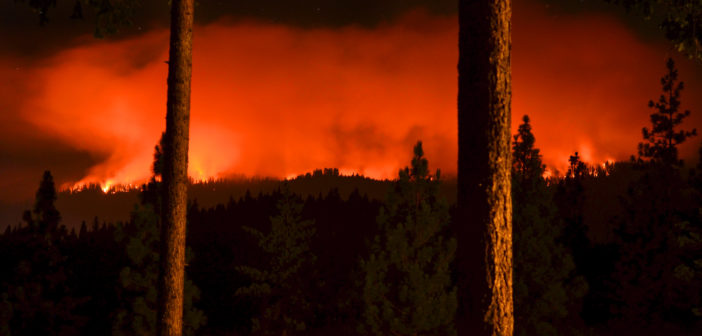Today the worsening climate crisis poses the greatest known threat to animals, humans and nonhumans alike. We are truly at an intersectional crossroads, where the interests of human, environmental, and animal rights converge. This is an example of what Buddhist monk Thich Nhat Hanh called interbeing. We now have many choices of drastically different paths, many options for what our planet will look like in the future.
The crossroads at which we find ourselves raises what could be the most fundamental questions in animal rights: Does the nonhuman world have the right to continue to exist? Do we have an obligation to protect the entire nonhuman kingdom? If other species do have the right to exist, what level of autonomy or liberation from humans should they be guaranteed, and what level of protection do we owe them from the incomparable suffering the climate crises will cause? Could their right to exist be derived, consequentially, from moral and legal obligations that exist between humans, in our environmental ethics and laws? Would consequential rights of this sort have to be determined first, before turning to our direct obligations to animals?
These most fundamental issues are being put to the test by the Animal Legal Defense Fund and Seeding Sovereignty, as we appeal the dismissal of our lawsuit challenging the utter failure of the United States government to mitigate or even stop intentionally exacerbating the climate crisis. These two organizations are ideally poised to bring this case. At its core the case is a question of justice, or demanding justification for the climate crisis being imposed upon us, and the limits of human power over the nonhuman world. Unlike other constitutional challenges to climate policy, this case expressly deals with the role of animal agriculture and family planning in the climate crisis and seeks to establish a nonhuman-centered baseline of environmental restoration as a constitutional right. The theory of the case is simple: The United States was founded on the concept of consent to human power and influence, which is logically impossible without restoration of the nonhuman world, or wilderness.

The lawsuit is based upon our constitutional liberty right to be “let alone,” or free from the unwanted intrusion of others into our lives and experiences. Supreme Court Justice Louis Brandeis argued that the founders had “conferred against the government, the right to be let alone – the most comprehensive of rights and the right most favored by civilized men.” This is the right to be self-determining, rather than be determined by others. This right was foundational to the the belief systems of the founders of the nation and guaranteed by the Declaration of Independence, Supreme Court precedent, and dozens of laws, including the Wilderness Act, where Congress made it clear that the only true form of being let alone or in solitude is to be in wilderness. In the Declaration of Independence, the founders built their conception of freedom around references to the “powers of the earth,” and “the separate and equal station to which the Laws of Nature and of Nature’s God entitle” us. That right, to be buffered from and thereby free of the influence of others, is what makes human autonomy and freedom possible. It is the background that we are constituted against, and what made us independent.
This may be a helpful analogy: Our laws and culture presume that people have an imaginary, or fictitious, bubble around them. People can say no to others touching, accosting or stalking them. It’s the “no, I do not consent” bubble. The climate crisis is collapsing that bubble, because we can’t say no to what the fossil fuel, big agriculture, and other industries are doing to us, to our experience of the world, and to our lives. They are trespassing upon us and attempting to define the future rather let it be natural, in the truest sense of the word. They are literally impacting the nature of human pregnancy, and the welfare of all future children. The unwanted touch, in the case of our plaintiffs, is immediately life-threatening, subjecting them to wildfires, thinning ice and unpredictable ice floes, deadly heat waves, and much more.

That’s a big problem – perhaps an existential one – for a country founded on personal freedom. Why respect the authority and laws of a government that cannot protect the security and freedom of its people? Indeed, a government that has become a threat to them?
We are at a constitutional moment, in which we are deciding the background environmental conditions against which we constitute ourselves into our various societies. This goes beyond consumption-based animal rights and environmentalism, to questions about who humans will be relative to the nonhuman world, and the family planning and other systems that will decide it. If we take animal liberation seriously – for humans and nonhumans – restoration of the nonhuman world, or the restorative baseline, must be the goal.
Freedom for humans and nonhumans alike is what the case is about – using the nonhuman word to choose the highest, safest, and most inclusive standards at this crucial crossroads – and it has massive implications for animal ethics and law. This is so because it answers, in very clear and applicable terms, the fundamental questions above. The nonhuman world is essential to human autonomy and flourishing, and must be protected and restored. Nature or the wild is not a human resource – it is nonhuman habitat. It is their home, and as the climate crisis is making painfully clear, its restoration and preservation is essential for the liberation of all species.
Our case argues that the right to be let alone logically requires a right to, and hence the preservation and restoration of, nature. As such, the case differs from other constitutional climate cases that use a human-centric baseline, like a stable atmosphere and livable environment for future generations of humans. This has implications for humans and nonhumans as the lower the baseline, the greater the risk that those most vulnerable will suffer. We argue that the right to be let alone, which sounds more in the realm of autonomy than welfare, and the high natural or restorative environmental baseline it implies, should be the target for constitutionally mandated mitigation targets and policies, as well as a baseline for distributional and retributive justice policies.
Nature is not on the spectrum or continuum of human freedom. It sets the spectrum, or the conditions in which live. It underpins the human experience, including all the ways we think of being “let alone,” e.g. to hide our data, to be secure in our homes, to terminate an unwanted pregnancy, etc. It makes that spectrum real, and therefore coherent.
The lower court held that there is no such right to be let alone, a decision that fundamentally undermines the principles upon which the country was founded and could play into the hands of dangerous separatists like the Bundy family. The decision caters to forces that seek to privatize all natural resources, see the world as marketplace, and would reduce freedom to a matter of pure consumption. Without a constitutional right blocking them, Congress and state legislatures could eliminate what’s left of nature in the United States, as there would be no objective limit on the proliferation of human power. And it’s that sort of dangerously shortsighted and ecocidal thinking that created the climate crisis that poses clear threat to even the national security of the United States. This lack of limits on our own power and influence over the nonhuman world makes our nation a threat to itself.
Without a restorative or pristine environment, which is the highest and safest standard for environmental protection, the anthropogenic effects – or the influences of other humans – will be forced upon us and will define our daily experiences. Instead of being self-determining people, our experiences will be determined by others, as they colonize and dominate our future.
The right to be let alone is nothing new and every day, in courts around the country, it is applied in many contexts, such as preventing entities like the government and others from spying on us in particular ways. But how could the government have an obligation to protect us from relatively minor intrusions into our liberty, like certain forms of surveillance, but not from intrusions – like the climate crisis – that cause untold suffering and threaten our lives? If climate change is a bad thing, what environment is the climate changing from – what was it before – and shouldn’t we be restoring it to that standard? Given that our previous environment is the only one proven to allow human flourishing, the answer seems obvious.

Why have courts not articulated the constitutional right to be truly free of others, or our right to the wilds of the nonhuman world? The world has not seen the likes of the climate crisis before, and the threat it poses to us and that world.
That is one reason why the case raises the issue of family planning reform, which is twenty-times more impactful in mitigating the climate crisis than commonly-used measures such as eating vegan and recycling. Family planning also builds more resilient future generations capable of dealing with compromised future ecosystems. One of the causes of our current predicament was our reliance on a family planning system that completely ignored the threat of things like greenhouse gas emissions, and allowed world population to double since the middle of the twentieth century. Ensuring the restoration of the nonhuman world is impossible without this reform. Family planning reform makes the use of the nonhuman world as an environmental policy baseline truly an act of interbeing and unification of social justice movements. We link the liberty created through a human rights-based system to the limitation of power we have over one another. This is the act of constituting ourselves as free people.
In other words, the animal protection movement was right in its recent turn to farmed animals, and the need to maximize impact. But it missed the mark with diet. Humans’ relationship to the nonhuman world begins at birth. Family planning is more impactful than diet, for humans and nonhumans alike. The key system failure is not the hegemony of big agriculture, but family planning systems that subverted democracy while subduing the nonhuman world. The voices of everyday people have been drowned out in the flood of humans that floated a relatively few powerful entities to the top of an economic pyramid scheme.
Perhaps the fundamental path to liberation for humans and nonhuman animals alike lies not solely in how we behave, but in the family planning systems that determine how we constitute ourselves. This suit, by establishing the value of and a right to the nonhuman world, is part of reforming those systems. There are dozens of other pathways for reform as well.
In the end, this case is about our understandings of freedom and autonomy and, as such, the government’s obligation to protect nature and wild places to the highest environmental standard in order to uphold Americans’ constitutional rights. It is about what we need to mean when we talk about “the environment,” and what it means to protect it in a way that prioritizes the nonhuman world. Grounding our environmentalism in animal liberation ideology liberates all of us, while seeing the earth as a resource for humans is what got us into this crisis in the first place. Given that the climate crisis poses the greatest threat of all to nonhumans, this lawsuit asks the core questions of animal rights and points out how we achieve their liberation and protection. The fact that they benefit as third-party beneficiaries of the antecedent human right to be let alone is of little consequence to them, as long as the outcome is the same.
Sadly, there is a sense of karma here – that our attack on the nonhuman world has become an attack on ourselves. The lawsuit is an opportunity to choose the best path forward, or the decidedly natural one, for nonhumans and humans alike. Restoring the nonhuman world is not just intersectional, comprehensive, and effective – it’s about the freedom from others liberalism promised, and as such, the very legitimacy of our governments.
Featured image: a forest fire burns in California. Image credit Fueling Creative Fire, CC BY-SA 2.0.





